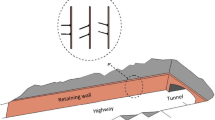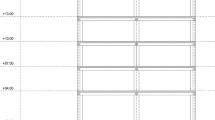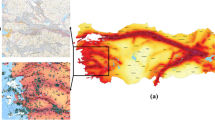Abstract
The embankment dam on the Qingcaosha Reservoir in Shanghai, China, was constructed on slightly or moderately liquefiable ground without a special foundation treatment. The designers considered to use the self-weight consolidation from the dam to improve its anti-liquefaction performance. To assess the liquefaction mitigation effects of this simple method, an effective stress analysis method was utilized to simulate the seismic responses of the reservoir dam. The numerical method was first validated using a centrifuge test. The dynamic performance of the dam was then analyzed for three cases: during a free-field period without dam construction (case 1), during completion of the construction of the dam in a short period of time (case 2), and 5 years after construction of the dam (case 3). The effects of liquefaction remediation were analyzed based on the excess pore water pressure ratio (EPWPR), the vertical and lateral displacements, the effective stress path, and stress-strain relationships. The remediation method, done using self-weight consolidation, reduced the EPWPR generated within the foundation soil, decreased the vertical settlement (from 27 to 20 cm) and the lateral displacement (from 21 to 20 cm) of the dam structure, and increased the stiffness of the foundation soil. In addition, the mechanisms underlying the remediation effects were also elucidated.















Similar content being viewed by others
References
Adalier K, Elgamal Ahmed W, Martin Geoffrey R (1998) Foundation liquefaction countermeasures for earth embankments. J Geotech Geoenviron 124(6):500–517
Adamidis O, Madabhushi GSP (2015) Use of viscous pore fluids in dynamic centrifuge modelling. Int J Phys Model Geotech 15(3):141–149
Bhatnagar S, Kumari S, Sawant VA (2016) Numerical analysis of earth embankment resting on liquefiable soil and remedial measures. Int J Geomech 16(1):04015029
Boulanger RW, K Z (2015) PM4Sand (Version 3): A sand plasticity model for earthquake engineering applications. Department of Civil and Environmental Engineering, University of California at Davis
Boulanger RW, Khosravi M, Khosravi A, Wilson DW (2018) Remediation of liquefaction effects for an embankment using soil-cement walls: centrifuge and numerical modeling. Soil Dyn Earthq Eng 114:38–50
Byrne PM, Park S-S, Beaty M, Sharp M, Gonzalez L, Abdoun T (2004) Numerical modeling of liquefaction and comparison with centrifuge tests. Can Geotech J 41(2):193–211
Chen Z, Yu H, Yuan Y (2014) Full 3D seismic analysis of a long-distance water conveyance tunnel. Struct Infrastruct Eng 10(1):128–140
Dafalias YF, Manzari MT (2004) Simple plasticity sand model accounting for fabric change effects. J Eng Mech 130(6):622–634
Elia G, Amorosi A, Chan AHC, Kavvadas MJ (2011) Fully coupled dynamic analysis of an earth dam. Géotechnique 61(7):549–563
Hamada M (2014) Soil liquefaction and countermeasures. Engineering for earthquake disaster mitigation. Springer Japan, Tokyo: 125-152
Huang Y, Yang Y, Wang L (2017) Evolution of anti-liquefaction performance of foundation soils after dam construction. Bull Eng Geol Environ
Huang Y, Zheng H, Zhuang Z (2012) Seismic liquefaction analysis of a reservoir dam foundation in the south–north water diversion project in China. Part I: liquefaction potential assessment. Nat Hazards 60(3):1299–1311
Huang Y, Zhu CQ (2017) Safety assessment of antiliquefaction performance of a constructed reservoir embankment. I: experimental assessment. J Perform Constr Facil 31(2):04016101
Iai (1990) Parameter identification for a cyclic mobility model. Rep Port Harbour Res Inst 29(4):57–83
Iai S (2018) Performance-based seismic design of geotechnical structures. In: Iai S (ed) Developments in earthquake geotechnics. Springer International Publishing, Cham, pp 1–23
Iai S, Matsunaga Y, Kameoka T (1992) Strain space plasticity model for cyclic mobility. Soils Found 32(2):1–15
Ichii K, Iai S, Sato Y, Liu H (2002) Seismic performance evaluation charts for gravity type quay walls. Struct Eng / Earthquake Eng 703:21s–31s
Idriss IM, Sun JI (1991) SHAKE91: a computer program for conducting equivalent linear seismic response analyses of horizontally layered soil deposits (with accompanying program). Center for Geotechnical Modeling, Dept. of civil and environmental engineering, University of California Press, Davis, CA
Ishihara K, Tatsuoka F, Yasuda S (1975) Undrained deformation and liquefaction of sand under cyclic stresses. Soils Found 15(1):29–44
Koga Y, Matsuo O (1990) Shaking table tests of embankments resting on liquefiable sandy ground. Soils Found 30(4):162–174
Koseki J, Tanaka H, Otsushi K, Nagao N, Kaneko M (2009) Model tests on levees reinforced with sheet piles. Seisan Kenkyu 61(6):1065–1068
Matsuo O (1996) Damage to river dikes. Soils Found 36(Special):235–240
Ministry of Construction of China (2010) Code for seismic design of buildings (GB 50011–2010). China Building Industry Press, Beijing (in Chinese)
Morishima N (2018) Effective stress analysis of river dikes during the 2011 East Japan earthquake. In: Iai S (ed) Developments in earthquake geotechnics. Springer International Publishing, Cham, pp 233–262
Newmark NM (1965) Effects of earthquakes on dams and embankments. Géotechnique 15(2):139–160
Ozutsumi O, Sawada S, Iai S, Takeshima Y, Sugiyama W, Shimazu T (2002) Effective stress analyses of liquefaction-induced deformation in river dikes. Soil Dyn Earthq Eng 22(9):1075–1082
Park YHKS, Kim SH, Kim MM (2000) Liquefaction of embankments on sandy soils and the optimum countermeasure against the liquefaction. Proceedings of 12th world conference on earthquake engineering Auckland, Paper No 1170
Seed HB (1979) Considerations in the earthquake-resistant design of earth and rockfill dams. Géotechnique 29(3):215–263
Singh R, Roy D, Jain SK (2005) Analysis of earth dams affected by the 2001 Bhuj earthquake. Eng Geol 80(3):282–291
Tetsuo Tobita SI (2007) Failure mechanism of an embankment resting on liquefiable ground. 4th International Conference on Earthquake Geotechnical Engineering Paper No1362
Towhata I, Ishihara K (1985) Shear work and pore water pressure in undrained shear. J Jap Soc Soil Mech Found Eng 25(3):73–84
Wang G (2017) Recent advances in geotechnical engineering of dams and embankments. Proceedings of the 19th international conference on soil mechanics and geotechnical engineering, Seoul 2017
Yang Z, Elgamal A, Adalier K, Sharp Michael K (2004) Earth dam on liquefiable foundation and remediation: numerical simulation of centrifuge experiments. J Eng Mech 130(10):1168–1176
Yang Z, Elgamal A, Parra E (2003) Computational model for cyclic mobility and associated shear deformation. J Geotech Geoenviron 129(12):1119–1127
Yasuda S, Towhata I, Ishii I, Sato S, Uchimura T (2013) Liquefaction-induced damage to structures during the 2011 great East Japan earthquake. JJSCE 1(1):181–193
Ye B, Ye G, Lu J (2017) Comparative study on the seismic performance of two types of quay wall structures. Marine Georesour Geotechnol 35(5):621–630
Ye B, Ye G, Zhang F, Yashima A (2007) Experiment and numerical simulation of repeated liquefaction-consolidation of sand. Soils Found 47(3):547–558
Ye B, Ye GL, Nagaya J, Sugano T (2012) Numerical simulation of shaking-table tests on soil-stabilized, geosynthetic-reinforced quay-wall structures. Geosynth Int 19(1):54–61
Zienkiewicz (1977) The finite element method, 3rd edn. McGraw-Hill, New York, USA
Acknowledgements
This work was supported by the Program of Shanghai Academic/Technology Research Leader (no. 17XD1403700), the National Natural Science Foundation of China (no. 41472249), the State Key Laboratory of Geo-Hazard Prevention and Geo-Environment Protection (no. SKLGP2016K019), and the Fundamental Research Funds for Central Universities.
Author information
Authors and Affiliations
Corresponding author
Rights and permissions
About this article
Cite this article
Ye, B., Xie, X., Wang, X. et al. Numerical analysis of the anti-liquefaction performance of a water reservoir dam under self-weight consolidation. Bull Eng Geol Environ 78, 5583–5597 (2019). https://doi.org/10.1007/s10064-019-01525-y
Received:
Accepted:
Published:
Issue Date:
DOI: https://doi.org/10.1007/s10064-019-01525-y




